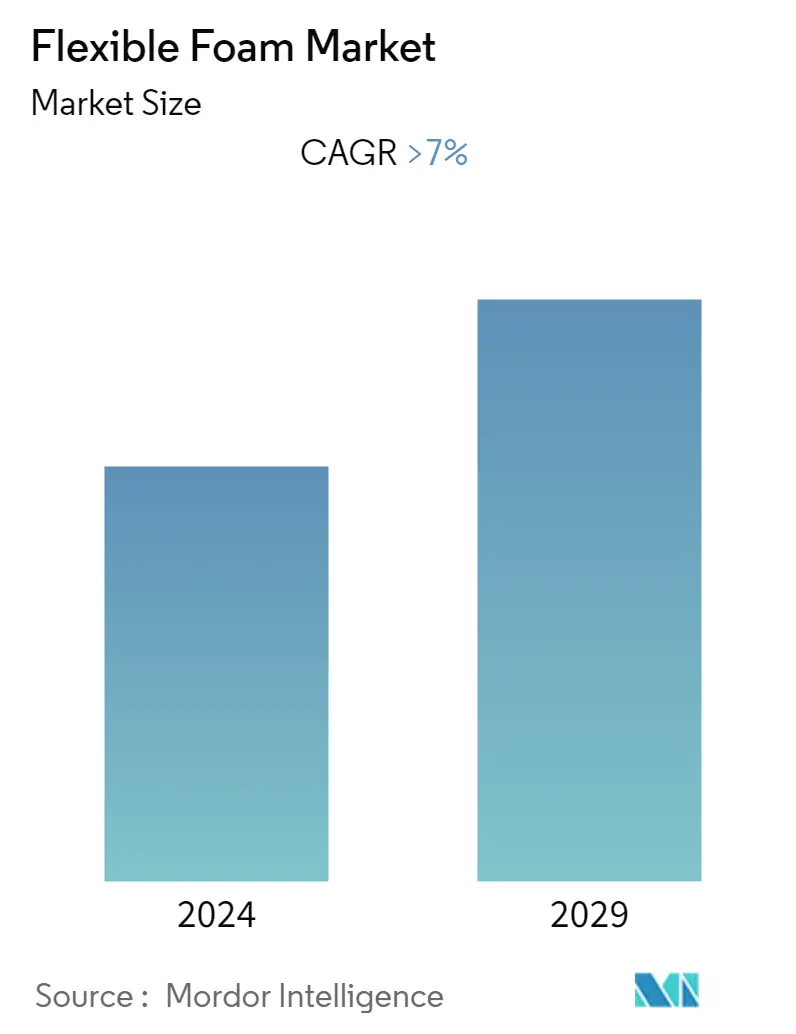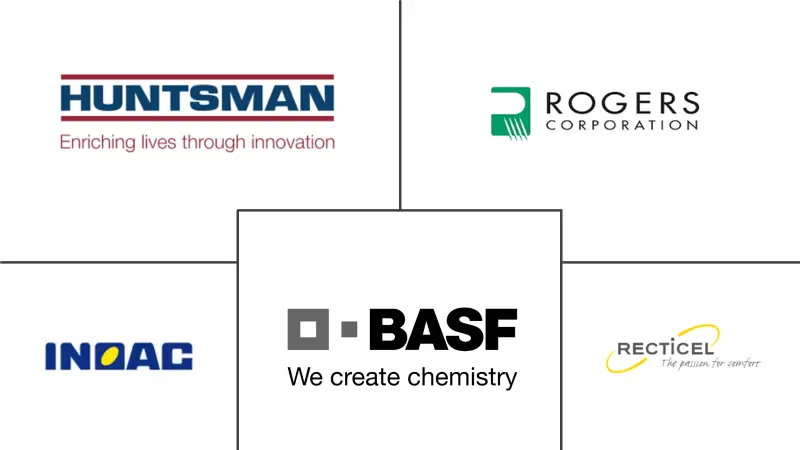Market Size of Flexible Foam Industry

| Study Period | 2019 - 2029 |
| Base Year For Estimation | 2023 |
| CAGR | 7.00 % |
| Fastest Growing Market | Asia-Pacific |
| Largest Market | Asia-Pacific |
| Market Concentration | Low |
Major Players
*Disclaimer: Major Players sorted in no particular order |
Flexible Foam Market Analysis
The flexible foam market is projected to register a CAGR of over 7% during the forecast period.
COVID-19 hurt the market for flexible foam because there was a big drop in demand from the construction, furniture, and auto industries.The lockdown hurt the building industry because many projects were put on hold, which led to less demand for furniture in homes and offices.However, the market gained pace in 2021 and is expected to grow at a healthy rate during the forecast period.
- The packaging industry's growing need for flexible foam material is the main thing that will drive the market studied over the next few years.Also, more carpet cushions are being made with flexible foam, which is expected to increase demand for the market studied.
- But the process of making flexible foam materials, which is expensive, is likely to slow the growth of the market studied.
- During the time frame of the forecast, the market is likely to benefit from the growing demand for cushion seats in electric vehicles.
- The Asia-Pacific region is expected to dominate the market globally, with the most consumption coming from countries such as China, India, and Japan.
Flexible Foam Industry Segmentation
Flexible foam is used to cushion a wide range of consumer and commercial products, such as furniture, carpet cushions, transportation, bedding, packaging, textiles, and fibers. The market is segmented by type, application, and geography. By type, the market is segmented into polyurethane, polyethylene, and polypropylene. By application, the market is segmented into construction, consumer goods, furniture, transportation, and other applications. The report also covers the market size and forecasts for the flexible foam market in 15 countries across major regions. For each segment, market sizing and forecasts have been done on the basis of revenue (USD million).
| Type | ||||
| ||||
| ||||
| Polypropylene |
| Application | |
| Construction | |
| Consumer Goods | |
| Furniture | |
| Transportation | |
| Other Applications |
| Geography | |||||||
| |||||||
| |||||||
| |||||||
| |||||||
|
Flexible Foam Market Size Summary
The flexible foam market is poised for significant growth, driven by its increasing application across various industries such as packaging, furniture, and automotive. The market experienced a downturn due to the COVID-19 pandemic, which led to reduced demand from key sectors like construction and automotive. However, it rebounded in 2021 and is expected to continue expanding at a robust pace. The Asia-Pacific region is anticipated to lead the market, with countries like China, India, and Japan contributing significantly to its growth. The rising demand for flexible foam in packaging and carpet cushions, along with its application in electric vehicle seating, is expected to further propel the market. Despite the high production costs of flexible foam materials, their advantageous properties, such as being lightweight and moldable, make them a preferred choice in various industrial applications.
Flexible foam's versatility and cost-effectiveness have made it a popular choice in the furniture industry, where it is used for items like child stools, office partitions, and bookshelves. The market is characterized by a few major players, including BASF SE, Rogers Corporation, and Huntsman International LLC, who dominate the landscape. Recent strategic moves, such as acquisitions and collaborations, have aimed at expanding production capabilities and enhancing product offerings. The growing automotive industry in China and Japan, coupled with the increasing demand for furniture in these regions, is expected to drive the market forward. As the market continues to evolve, the Asia-Pacific region is set to maintain its dominance, supported by the expanding end-user industries and the rising need for flexible foam solutions.
Flexible Foam Market Size - Table of Contents
-
1. MARKET DYNAMICS
-
1.1 Drivers
-
1.1.1 Growing Demand of Flexible Foam in Packaging
-
1.1.2 Increasing Demand for Flexible Foam in Carpet Cushion
-
1.1.3 Other Drivers
-
-
1.2 Restraints
-
1.2.1 Environmental Degradation while Fabrication
-
1.2.2 Other Restraints
-
-
1.3 Industry Value Chain Analysis
-
1.4 Porter's Five Forces Analysis
-
1.4.1 Bargaining Power of Suppliers
-
1.4.2 Bargaining Power of Buyers
-
1.4.3 Threat of New Entrants
-
1.4.4 Threat of Substitute Products
-
1.4.5 Degree of Competition
-
-
1.5 Raw Material Analysis
-
-
2. MARKET SEGMENTATION (Market Size in Value)
-
2.1 Type
-
2.1.1 Polyurethane
-
2.1.1.1 Polyester
-
2.1.1.2 Polyether
-
-
2.1.2 Polyethylene
-
2.1.2.1 Cross linked
-
2.1.2.2 Non-cross linked
-
-
2.1.3 Polypropylene
-
-
2.2 Application
-
2.2.1 Construction
-
2.2.2 Consumer Goods
-
2.2.3 Furniture
-
2.2.4 Transportation
-
2.2.5 Other Applications
-
-
2.3 Geography
-
2.3.1 Asia-Pacific
-
2.3.1.1 China
-
2.3.1.2 India
-
2.3.1.3 Japan
-
2.3.1.4 South Korea
-
2.3.1.5 Rest of Asia-Pacific
-
-
2.3.2 North America
-
2.3.2.1 United States
-
2.3.2.2 Canada
-
2.3.2.3 Mexico
-
-
2.3.3 Europe
-
2.3.3.1 Germany
-
2.3.3.2 United Kingdom
-
2.3.3.3 Italy
-
2.3.3.4 France
-
2.3.3.5 Rest of Europe
-
-
2.3.4 South America
-
2.3.4.1 Brazil
-
2.3.4.2 Argentina
-
2.3.4.3 Rest of South America
-
-
2.3.5 Middle-East and Africa
-
2.3.5.1 Saudi Arabia
-
2.3.5.2 South Africa
-
2.3.5.3 Rest of Middle-East and Africa
-
-
-
Flexible Foam Market Size FAQs
What is the current Flexible Foam Market size?
The Flexible Foam Market is projected to register a CAGR of greater than 7% during the forecast period (2024-2029)
Who are the key players in Flexible Foam Market?
BASF SE, Recticel NV/SA, Huntsman International LLC, Rogers Corporation and Inoac Corporation are the major companies operating in the Flexible Foam Market.

